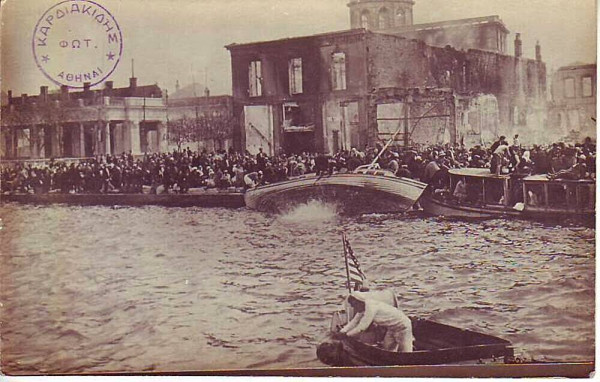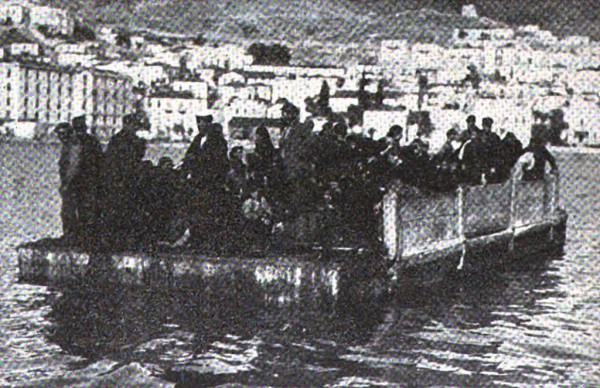
Catastrophe of Smyrna in 1922.
Ishtartv.com – greekherald.com.au
By Dr. Themistocles Kritikakos (Historian), 23 / 05 / 2025
Earlier this week, the Greek-American organisation, the Eastern
Mediterranean Business and Cultural Alliance (EMBCA), held its third Forum on
the Greek Genocide—a subject long confined to the margins of history. The event
brought together scholars and researchers to explore the historical processes
that contributed to the persecution and destruction of Christian
minorities—Armenians, Greeks, and Assyrians—during the final years of the
Ottoman Empire.
Moderated by EMBCA President Lou Katsos, the panel presented research
examining the political and ideological dynamics that shaped this period of
mass violence and displacement, which resulted in the deaths of an estimated
three million Armenians, Greeks, and Assyrians between 1914 and 1923, including
more than 750,000 Greeks from Asia Minor (including Pontus) and Eastern Thrace.
At the forum, my presentation, From Empire to Nation-State:
Nationalism, Ethnic Homogenisation, and the Elimination of Minorities in
the Late Ottoman Empire, examined the institutional and ideological
drivers of the persecution of Armenians, Greeks, and Assyrians from the 1870s
until 1924.
Several distinguished academics and researchers contributed to the
forum, including Lou Ureneck, retired journalism professor at Boston University
and author of The Great Fire; Dr Vasileios Meichanetsidis, author of The
Genocide of the Ottoman Greeks; Dr Fatma Müge Göçek of the University of
Michigan, author of Denial of Violence; Dr Theodosios Kyriakidis, Chair for
Pontic Studies at Aristotle University of Thessaloniki; and Savvas (Sam)
Koktzoglou, co-author of The Greek Genocide in American Naval War Diaries.
Reconceptualising Genocide as a gradual and evolving process
My presentation traced the transition from imperial pluralism to
ethnic nationalism in the late Ottoman Empire, highlighting the systematic
elimination of Armenians, Greeks, and Assyrians. It demonstrated that
genocide emerged through interconnected phases of state-led persecution
characterised by demographic engineering, ideological radicalisation, and
cumulative violence under successive regimes.
Drawing on the work of leading genocide scholar of the late Ottoman
period, Taner Akçam, I argued that genocide is best understood not as a series
of isolated events, but as a cumulative and evolving process. It begins with
ideological dehumanisation and progresses through systematic administrative
measures. These include legal discrimination, surveillance, propaganda,
economic boycotts, demographic restructuring, and bureaucratic marginalisation,
ultimately culminating in mass violence and extermination.
The Ottoman Empire governed its diverse population through the millet
system, which granted limited autonomy to religious minorities such as
Christians. Despite this, Armenians, Greeks, and Assyrians, were
still classified as second-class citizens. However,
they had deep historical roots in the region and played vital
roles in the empire’s cultural and economic life.
From the nineteenth century onwards, political shifts began to challenge
this multi-ethnic system. The Tanzimat reforms (1839–1876)
sought to modernise the empire and grant equal citizenship to all subjects, but
these efforts provoked conservative backlash and ultimately failed to resolve
minority grievances. The 1878 Treaty of Berlin, which endorsed reforms for
Armenians following the Russo-Ottoman War, intensified suspicions that
Christian minorities were aligned with foreign powers.
Under Sultan Abdulhamid II (1876-1909), authoritarianism
increased, culminating in the Hamidian massacres of 200,000 Armenians
and 20,000 Assyrians between 1894 and 1896. The 1908 Young Turk
Revolution briefly raised hopes for equality. However, the Committee of Union
and Progress (CUP)—the political party of the Young Turks—soon asserted a
centralised, nationalist agenda amid growing political instability in the
empire.
Following the Adana massacres of approximately 20,000 Armenians in
1909—amid political tensions between supporters of Sultan Abdulhamid II and the
Committee of Union and Progress (CUP), and broader challenges to reform within
the empire—the CUP, at its 1910 and 1911 congresses, advocated the use of force
to achieve Ottomanisation, viewing Christian minorities as obstacles to
preserving an empire in crisis.
Territorial losses and the mass exodus of Muslims following the Balkan
Wars (1912–1913) contributed to the radicalisation of the Young Turks, who
began to view Armenians, Greeks, and Assyrians as unassimilable internal
enemies. The persecution of Greeks in Eastern Thrace in 1913 marked an early
manifestation of this shift, which escalated further in both Eastern Thrace and
Western Anatolia in 1914. These events escalated the broader process of
Turkification, characterised by land confiscations, mass violence, and the
expulsion of Christian minorities.
Between 1914 and 1923, Armenians, Greeks, and Assyrians endured a
coordinated campaign of persecution orchestrated first by the Young Turks and
later by the Turkish Nationalist Movement. This campaign encompassed the First
World War (1914–1918)—although Greece only entered the conflict in June
1917—and continued through the Greco-Turkish War (1919–1922). It included
targeted violence against Greeks in Eastern Thrace and Western Anatolia, as
well as Assyrians in Eastern Anatolia in 1914; the Armenian Genocide of 1915;
the persecution of Pontian Greeks in 1916; ongoing violence in Pontus from 1921
to 1922; and the Catastrophe of Smyrna in 1922. While often studied separately,
these events were interconnected events within a broader period of displacement
and violence that began in the late nineteenth century and culminated in the
1923 Population Exchange.
Despite changes in leadership and variations in how each group was
targeted, successive Ottoman and Turkish regimes perceived Armenians, Greeks,
and Assyrians as unassimilable existential threats and portrayed them as
disloyal subjects collaborating with the Great Powers. Through dispossession,
deportation, and extermination—driven by nationalist ideologies and internal
political struggles—these regimes aimed to achieve national homogenisation.
The concept of cumulative radicalisation closely aligns with genocide
scholar Dirk Moses’s notion of the “problem of permanent security,” whereby
states, in their pursuit of lasting stability, perceive certain minority
populations as unassimilable and persistent threats to national cohesion.
Armenians, Greeks, and Assyrians—some of whom advocated for reform or
autonomy—were viewed as fundamentally incompatible with the preservation of the
disintegrating Ottoman Empire and, later, the construction of the Turkish
nation-state.
This violence was carried out by central and local Ottoman authorities,
military forces, paramilitaries, and local collaborators—including some members
of Kurdish and Arab tribes. Although Armenians, Greeks, and Assyrians were
the primary targets, other minorities—including Maronites, Antiochian Greeks of
the Levant, Yezidis, Kurds, and Jews—also suffered various forms of
persecution, a subject that warrants further research.
The Paris Peace Conference (1919–1920) and the Treaty of Sèvres (1920)
aimed to redraw territorial boundaries and establish a new order following the
breakdown of the Ottoman Empire. However, these initiatives collapsed due to
shifting political priorities, the absence of a clear legal framework, and a
lack of sustained international resolve—ultimately allowing the perpetrators to
escape punishment. The 1923 Treaty of Lausanne established new national
borders, and the subsequent population exchange between Christians in Turkey
and Muslims in Greece contributed to further demographic shifts.
Turkish historical narratives have traditionally emphasised themes of
national survival and triumph over perceived internal dissent and foreign
intervention. In doing so, it has often sidelined the experiences of minority
communities, downplaying or overlooking the extent of their suffering. Violent
actions against these groups have frequently been depicted as unfortunate but
essential measures to maintain national cohesion or as inevitable consequences
of the turmoil and chaos of war.
Through processes of dehumanisation and delegitimisation, minority
groups came to be perceived as threats, creating conditions in which genocidal
acts were justified as necessary for preserving or restoring state integrity.
Nationalism, anchored in ethnic and religious exclusivity, shaped the final
decades of the empire and significantly influenced the formation of the modern
Turkish Republic through a project of monocultural homogenisation. By fully
examining this history through academic research and dedicated education
initiatives, we gain vital understanding of the past that shapes contemporary
dialogues on intergenerational trauma, accountability, and political
recognition.

Evacuation of Pontian Greeks from Samsun in 1923.

Panel Discussion.
|